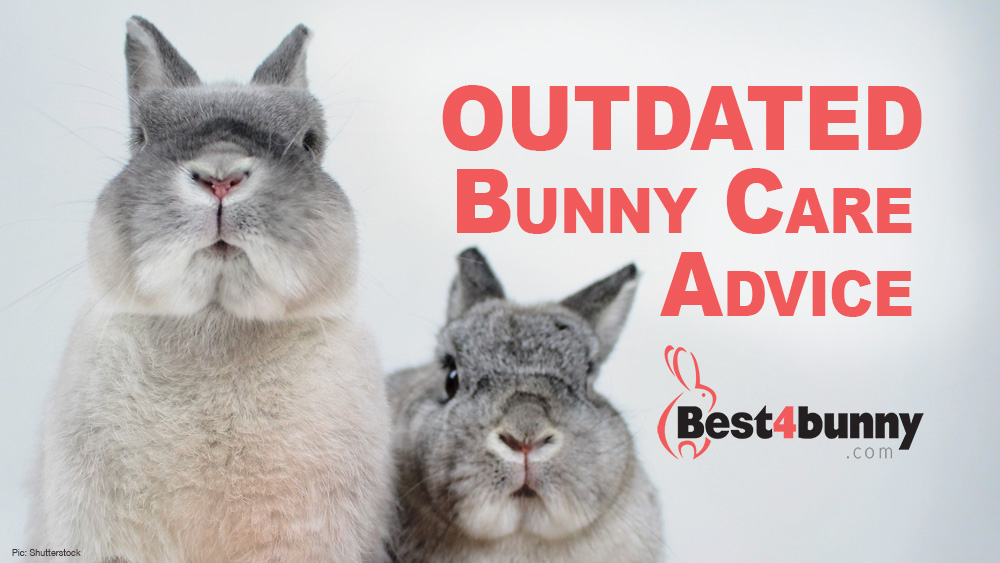
“Well, back in my day”… that saying usually implies that what was done years ago was better than what is being done now. In some cases, this may be true; however, on the topic of bunny care, lots of things have changed. What was done “back in my day” is no longer the best option for taking care of, feeding and housing pet rabbits. Here are some examples:
Keeping rabbits in a hutch or cage
Even now you will see hutches and cages in stores or advertised on the internet that are advertised as “rabbit cages”. These are remarkably small for an animal that was born to run and jump. In truth, there is no hutch or cage large enough to allow your rabbit to get enough exercise and not feel trapped. Rabbits need LOTS of space to roam, around 12 square feet at a minimum. Understandably, it is sometimes not feasible to give your bunny run of the whole house and definitely not safe to give them the run of the garden when you are not there to supervise them, so what can make an ideal home for bunnies today?
Exercise puppy pens are a great alternative for house bunnies. These typically have high enough sides to prevent your pet from hopping out, no top so they won’t feel caged, and can provide plenty of safe space for them to really get the zoomies! Cat and dog kennels can make great homes for outdoor bunnies. Also converted sheds with a secure exercise run attached to them.
Bathing your bunny
It was once believed that bathing your rabbit occasionally is good for their skin and coat. This is most definitely not true! If your pet is kept in a sanitary environment, they should never need a bath; rabbits do a very good job at keeping their skin and coat clean and fluffy themselves. Rabbits and water do not mix. Placing a rabbit in water could put them into shock, which is deadly. Also, rabbit fur does not shed water so it takes a very long time for rabbits to dry off completely. A wet rabbit can very quickly develop hypothermia.
If ever your bunny does need a bath – in the case where they got something sticky on their fur or they were ill and need a “butt bath” to help them get their nether regions cleaned – there are safe ways to very gently bathe them. Bathing the soiled area only in shallow water is all that is needed. This should be done only when absolutely necessary.
Providing dried food 24/7
It used to be commonplace to ensure your rabbit’s bowl was filled with dried food every day to provid your fluffy bun with vital vitamins and minerals they otherwise lacked in their diet. We now know this isn’t true. The ideal rabbit menu should include leafy greens and an infinite supply of fresh, good quality meadow and/or timothy grass hay. It is still ok to give your rabbit dried food, but they need to be a good quality pellet and should only be fed sparingly. Read the packet to work out the right quantity to your rabbits size/weight. Usually a egg cup full or small handful is all that is needed. Pellets do provide nutritional value, but if you’ve too many then rabbits tend to overfeed on them; causing obesity and preventing them from getting their true nutrients from hay.
Also, avoid the muesli type rabbit food which are brightly coloured and have a mixture of dried corn, peas and seeds. These mixes may look appetising and claim to be healthy, but they are loaded with unnecessary sugars and can cause your rabbit to become very ill.
Rabbit’s love to eat carrots
One of the most common outdated bunny care advice is that many people think carrots is the main food for rabbits to eat and that they should eat lots of them. This is thanks to the cartoon character Bugs Bunny! Yes, rabbits do love to eat carrots but did you know they are actually very bad for rabbits if eaten in large quantities. Carrots are full of sugar and can cause all kinds of health problems from obesity to dental issues in rabbits. If you are going to feed your rabbit carrot make sure you give them as a small treat only. The size of a pound coin is more than enough!
Picking rabbits up often
Many people think that if you pick up your rabbit often, they will get used to being held and learn to enjoy being cuddled… FALSE! Rabbits get very stressed out when they are picked up and no amount of cuddling will drive away this fear. As natural prey animals, rabbits do not have many ways to defend themselves except to flee. Picking up and holding your rabbit takes away their ability to escape and causes them to feel trapped and panicked. This can cause the bunny to kick and fling themselves out of your grasp, which could result in serious injury or even death.
Other rabbits will freeze with fear giving a false impression that they are ok with being held. Listen to their breathing. If it faster than normal, they are stressed. Place your finger under their front foot and if they grip your finger tightly, then they are far from relaxed.
It is far better to lay on the ground and interact with your pet on their level. Once your bunny feels like you are not trying to trap them, they will become more comfortable approaching you.
Education on how to look after rabbits today, is key!
What used to be considered excellent care “back in the day” may have worked for some pets, but research has shown that rabbits live much more enriching lives when provided with care specific to their needs. Learning about caring for rabbits the right way today like proper diet, housing and handling will make your bunny a very healthy and happy member of your fur family for a long time!
Written by Shelby Stone, keeper of the Mile High Menagerie. Full time mom to fur and feather babies, a software engineer and social media manager at Small Pet Select.
Find more bunny advice and tips in our Best4bunny Magazines



